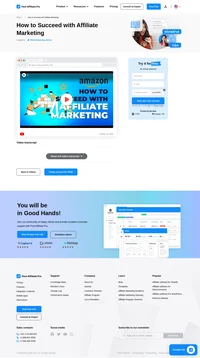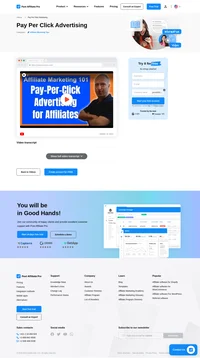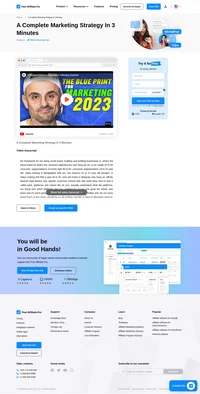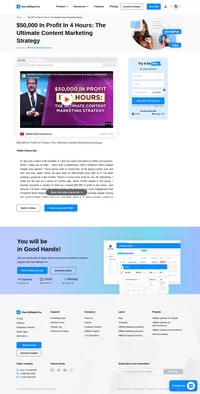Languages
America- English
- Português
–Hidden comment
Use attributes in format region_from and region_to= to change the languages showing in language switcher.
Available regions are:
europe_from europe_to
asia_from asia_to
mideast_from mideast_to
america_from america_to
Example:
europe_from=0 europe_to=22 will put all languages (ordered in language switcher settings) from 1 to 21 to Europe region:
asia_from=22 asia_to=25 will put all languages from 23 to 24 (so only 2) into Asia region.
- Videos
- 5 Strategies to Dominate All Google Ads Platforms
5 Strategies to Dominate All Google Ads Platforms
Optimize campaign data using CPA, Google's AI, and native search remarketing. Enhance click-through rates with YouTube countdown timers. These strategies boost affiliate marketing performance and income.


5 Strategies to Dominate All Google Ads Platforms
Mastering Affiliate Marketing: 5 Key Strategies for Google Ads Success
Affiliate marketing thrives on strategic use of various platforms, and Google Ads is one of the most potent tools in an affiliate marketer's arsenal. By leveraging Google Ads effectively, affiliates can drive targeted traffic, optimize conversion rates, and significantly boost their income. Let’s delve into five crucial strategies that can help dominate Google Ads platforms.
Understanding Cost Per Lead and Cost Per Acquisition
Before diving into campaign adjustments, affiliates must grasp the concepts of Cost Per Lead (CPL) and Cost Per Acquisition (CPA). Calculate your CPL by dividing your Cost Per Click (CPC) by your conversion rate. This figure is pivotal as it dictates the minimum spend before making any campaign changes. For instance, if your CPL is $12, apply multipliers for different campaign elements like placements (x3) or ads (x6) to determine necessary investments.
Patience with Campaign Learning
Expecting immediate results from CPA campaigns can be misleading. Affiliates should allow at least two weeks for Google’s AI to learn and optimize campaign data. This period enables the AI to effectively analyze and adjust strategies, potentially starting to yield results from day one but often requiring a fortnight for substantial progress.
A/B Testing for Enhanced Performance
A/B testing is an invaluable tool for affiliates seeking to optimize their campaigns. For example, in a home security campaign, a small adjustment reduced the cost per conversion significantly, resulting in an additional $18,200 net income monthly. Testing various elements allows affiliates to refine their strategies for maximum efficiency and profitability.
Utilizing Native Search Remarketing
Implementing native search remarketing can boost visibility and conversion rates. This involves launching search campaigns targeting competitors and creating white-label sites that discreetly promote your affiliate offers. While these sites rank competitors, your product remains prominently featured, subtly steering potential customers back to your offer.
Boosting Click-Through Rates with Simple Hacks
To enhance click-through rates (CTR), consider adding countdown timers at the end of videos. This small tweak generates urgency, prompting viewers to act quickly. Such strategies have consistently delivered up to 40% increases in CTR, proving effective in driving engagement and conversions.
FAQs
What is the importance of CPL and CPA in affiliate marketing?
CPL and CPA are critical as they help determine the profitability of your campaigns. Understanding these metrics allows you to allocate your budget efficiently and make informed decisions about campaign adjustments.
How long should I wait for Google Ads to optimize my campaign?
Allow at least two weeks for Google’s AI to learn and optimize your campaign. This timeframe helps ensure that the campaign data is thoroughly analyzed for the best possible outcome.
How can A/B testing benefit my affiliate marketing campaigns?
A/B testing helps refine your campaign strategies by comparing different versions and identifying the most effective elements. This process can lead to improved conversion rates and greater profitability.
What is native search remarketing, and how does it work?
Native search remarketing involves targeting competitors through search campaigns and using white-label sites to subtly promote your products. This technique increases visibility and can redirect potential customers to your affiliate offers.
Why are countdown timers effective in increasing CTR?
Countdown timers create a sense of urgency, encouraging viewers to act quickly before time runs out. This psychological trigger can lead to higher engagement and conversion rates.
Video transcript
To show you right now, you multiply the CPL.
or CPA that you got to that specific step. This is the minimum that you have to spend.
before you decide to make any changes to that step. So what you do is you take your CPC, you divide.
it by your conversion rate, you're gettingthe CPL, right?Okay so for each step that I'm going to show.
you right now, you multiply the CPL or CPAthat you got to that specific step. This is the minimum that you have to spend.
before you decide to make any changes to thatstep. Changes could be excluding it from the campaign.
and segmenting into another campaign, bidadjusting, killing it, whatever you decide,.
okay?And that's also the order of optimisation. So if your CPL or CPA is for example $12,.
for each step that you see right now you multiplethe CPL or CPA according to that step, okay?So placements x3, ads x6, and so on and so.
on like you see. So you have the minimum amount. You don't expect the result from day 1. What happens most of the time when you setup.
your campaign to a CPA mode, sometime thecost goes up. So let's say you have a conversion setting.
or goal or $10 and you set it to your CPAand it goes up to $12 or $13 the next day.
and you're like okay, no this is not working. Now, it does not work like that. You just reduce your CPA target to $8 and.
let it run for at least 2 weeks. 2 weeks is what it takes for Google's AI to.
learn and optimise your campaign data. Don't expect anything. I mean it can start from day 1, it can do.
wonders from day 1 but let it run for at least2 weeks. 2 weeks is the minimum time to let Google's.
AI to analyse your data and track it. Here's a campaign A/B testing of home security.
campaign which I ran. On the above you can see we got a conversion.
rate of about $68 and on the below you cansee on the same campaign we were able to reduce.
our per cost conversion to $61. 84, that's$18,200 extra net income on one campaign per.
month. So that's the power of CPA which you can use.
and utilise in your campaigns. It's something that I call "native" search.
remarketing. It's just like a wide way of really pushing.
and really hardcore selling to that person. For example if I'm running an online mattress.
site, I have my product there and I have mylanding page and everything. What I like to do with the guys who didn't.
leave any details or didn't buy the product,I would start a search campaign on Google.
and I would target every one of my competitorsand of course I would open up a different.
campaign for my specific brand. I would kill those people with another site. That site would be a white-label site. It wouldn't have anything relating me to that.
product. It might be an aggregation, a top 10 site.
with all of the top 10 mattresses online andmine would be, of course you guessed it, at.
the top. The next thing that you gotta do is make sure.
that you actually turn on the targeting networksspecifically in the shopping campaigns, alright?So when you're actually setting a campaign.
up, Google's gonna as you like hey do youwant your products to show up on the search.
network, do you want your products to showup on YouTube. The search network mostly is checked by default.
but YouTube, if you guys don't have that checked,you wanna go inside your campaigns right now.
and check that so you can start actually runningtraffic on YouTube too as well. So let's talk about how you can increase your.
click-through rates. Some really simple hacks that work really.
well with YouTube. The first thing you can do is add countdown.
timers at the end of your video. This will dramatically improve your click-through.
rate. It does it every single time. It's just a little bit of an edit at the end.
of your video. So at the end of your video, all you're gonna.
wanna do is count down from 5 seconds at theend. You're doing 2 things. One, you're allowing the viewer to have a.
little bit of time to get ready to click becausewhat you don't wanna do is have them get to.
the end of the video and the just the videothat you're about to watch just loads up instead. That's a lost click that you could've had.
and so you give them time but the other thingis you're adding scarcity. It's just a natural scarcity at the end of.
your video and scarcity makes people takeaction. One evergreen marketing campaign. Click here and learn for free. And then you can see the countdown timer coming.
in. That's exactly what it looks like. It runs, it works really well. You may have seen on the top lefthand corner.
of the video, it says get ready to click. Did you see that?By adding those two things together, we had.
a 40% increase in click-through rate.
How to Succeed with Affiliate Marketing
Discover the secrets to thriving in affiliate marketing with our expert video guide! Learn essential tips on building trust, addressing audience needs, and effectively promoting Amazon products. Elevate your affiliate strategy by prioritizing honesty and creating unique content that stands out. Watch now to transform your affiliate marketing success!
Affiliate Marketing Mastery in 5 Minutes
Unlock the potential of affiliate marketing in just 5 minutes with Adam Enfroy's insightful video on Post Affiliate Pro. Learn how to build a content-driven affiliate marketing machine and tap into a trillion-dollar industry. Discover strategies for creating organic traffic and crafting helpful content that drives sales. Perfect for anyone wanting to master affiliate marketing with effective tools and strategies. Watch now to start your journey towards a successful, diversified affiliate marketing business!
A Complete Marketing Strategy In 3 Minutes
Discover the essentials of crafting a standout marketing strategy in just 3 minutes with GaryVee. Learn about social brand building, consumer segmentation, and platform allocation to optimize your business objectives. Perfect for affiliate marketers looking to allocate resources effectively and engage target audiences for impactful results. Watch now and transform your marketing approach!
$50,000 In Profit In 4 Hours: The Ultimate Content Marketing Strategy
Discover how to generate $50,000 in just 4 hours with the ultimate content marketing strategy! Learn to build relationships, trust, and passionate audiences that engage repeatedly. Watch the video from Affiliate World Conferences and unlock the secrets to transforming content into profits.
You will be
in Good Hands!
Join our community of happy clients and provide excellent customer support with Post Affiliate Pro.

Our website uses cookies. By continuing we assume your permission to deploy cookies as detailed in our privacy and cookies policy.
Schedule a one-on-one call and discover how Post Affiliate Pro can benefit your business.
We’re available on multiple dates








